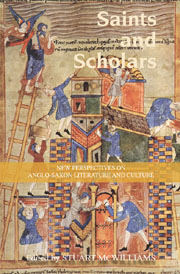 Saints and Scholars
Saints and Scholars Book contents
- Frontmatter
- Contents
- List of Contributors
- Abbreviations
- Introduction
- I Hagiography and the Homiletic Tradition
- II Aspects of Community and Consumption
- 8 Stories from the Court of King Alfred
- 9 De Duodecim Abusiuis, Lordship and Kingship in Anglo-Saxon England
- 10 Reluctant Appetites: Anglo-Saxon Attitudes towards Fasting
- 11 A Note on the Function of the Inscribed Strip from the Staffordshire Hoard
- 12 The Shining of the Sun in the Twelve Nights of Christmas
- 13 Sin and Laughter in Late Anglo-Saxon England: The Case of Old English (h)leahtor
- 14 Marginal Activity? Post-Conquest Old English Readers and their Notes
- III Reflections on Old English Scholarship
- Poems
- Hugh Magennis: A Bibliography, 1981–2011
- Index
- Tabula Gratulatoria
14 - Marginal Activity? Post-Conquest Old English Readers and their Notes
from II - Aspects of Community and Consumption
Published online by Cambridge University Press: 05 February 2013
- Frontmatter
- Contents
- List of Contributors
- Abbreviations
- Introduction
- I Hagiography and the Homiletic Tradition
- II Aspects of Community and Consumption
- 8 Stories from the Court of King Alfred
- 9 De Duodecim Abusiuis, Lordship and Kingship in Anglo-Saxon England
- 10 Reluctant Appetites: Anglo-Saxon Attitudes towards Fasting
- 11 A Note on the Function of the Inscribed Strip from the Staffordshire Hoard
- 12 The Shining of the Sun in the Twelve Nights of Christmas
- 13 Sin and Laughter in Late Anglo-Saxon England: The Case of Old English (h)leahtor
- 14 Marginal Activity? Post-Conquest Old English Readers and their Notes
- III Reflections on Old English Scholarship
- Poems
- Hugh Magennis: A Bibliography, 1981–2011
- Index
- Tabula Gratulatoria
Summary
The textual traditions of Anglo-Saxon England extend well beyond the Norman Conquest. Old English texts were copied into hundreds of manuscripts from 1060 to the early thirteenth century, and marginal annotations were made to many of them. This phenomenon is striking for two reasons: firstly, the continuing rewriting of Old English for such a long time after the Norman Conquest, and in such quantity, testifies to both continuity and change; secondly, annotation is an explicit sign of the use of these manuscripts, and so reinforces our growing understanding of post-Conquest Old English as a living tradition.
From 2005 to 2010, the Arts and Humanities Research Council-funded research project The Production and Use of English Manuscripts 1060 to 1220 scrutinised post-Conquest Old English manuscripts to produce a much clearer mapping of their contents and production contexts and to nuance our understanding of their place in the textual cultures of Anglo-Norman England. New work shows these textual cultures to be complex and layered, woven from old and new, English, French and Latin, with different traditions, languages and genres in conversation. Until recently, post-Conquest Old English manuscripts were at the margins of the scholarly view of Anglo-Norman textual culture, and their marginal annotations were peripheral even to that. Now that the subject has gained currency, it is possible to examine specific examples in their manuscript and cultural contexts, and to consider what they imply about bigger questions of language use, textual traditions and trends old and new in twelfth-century England.
- Type
- Chapter
- Information
- Saints and ScholarsNew Perspectives on Anglo-Saxon Literature and Culture in Honour of Hugh Magennis, pp. 224 - 233Publisher: Boydell & BrewerPrint publication year: 2012


